Nicholas Roerich
| Nicholas Roerich | |
|---|---|
 | |
| Born |
October 9, 1874 Saint Petersburg, Russian Empire |
| Died |
December 13, 1947 (aged 73) Naggar, Himachal Pradesh, India |
| Nationality | Russia |
| Occupation | painter, archaeologist, costume and set designer for ballets, operas, and dramas |
| Spouse(s) | Helena Roerich |
| Children |
George de Roerich, Svetoslav Roerich |
Nicholas Roerich (/ˈrɜːrɪk/; October 9, 1874 – December 13, 1947) – known also as Nikolai Konstantinovich Rerikh (Russian: Никола́й Константи́нович Ре́рих) – was a Russian painter, writer, archaeologist, theosophist, perceived by some in Russia as an enlightener,[1] philosopher, and public figure, who in his youth was influenced by a movement in Russian society around the occult. He was interested in hypnosis and other spiritual practices and his paintings are said to have hypnotic expression.[2][3]
Born in Saint Petersburg, Russia, to a well-to-do notary public of Baltic German ancestry and a Russian mother,[4] he lived in various places around the world until his death in Naggar,[5] Himachal Pradesh, India. Trained as an artist and a lawyer, his main interests were literature, philosophy, archaeology, and especially art. Roerich was a dedicated activist for the cause of preserving art and architecture during times of war. He earned several nominations for the Nobel Peace Prize long list.[6] The so-called Roerich Pact was signed into law by the United States and most nations of the Pan-American Union during April 1935.
Biography
Early life

Raised in late 19th century St. Petersburg, Roerich matriculated simultaneously at St. Petersburg University and the Imperial Academy of Arts during 1893. He received the title of "artist" during 1897 and a degree in law the next year. He found early employment with the Imperial Society for the Encouragement of the Arts, whose school he directed from 1906 to 1917. Despite early tensions with the group, he became a member of Sergei Diaghilev's "World of Art" society; he was president of the society from 1910 to 1916.
Artistically, he became known as his generation's most talented painter of Russia's ancient past, a topic that was compatible with his lifelong interest in archaeology. He also succeeded as a stage designer, achieving his greatest fame as one of the designers for Diaghilev's Ballets Russes. His best-known designs were for Borodin's Prince Igor (1909 and later productions), and costumes and set for The Rite of Spring (1913),[7] composed by Igor Stravinsky.
Another of Roerich's passions was architecture. His acclaimed publication "Architectural Studies" (1904–1905) – the dozens of paintings he completed of fortresses, monasteries, churches, and other monuments during two long trips through Russia—- inspired his decades-long career as an activist on behalf of artistic and architectural preservation. He also designed religious art for places of worship throughout Russia and Ukraine: most notably the Queen of Heaven fresco for the Church of the Holy Spirit which the patroness Maria Tenisheva built near her Talashkino estate; and the stained glass windows for the Datsan Gunzechoinei during 1913–1915.
During the first decade of the 1900s and in the early 1910s, Roerich, largely due to the influence of his wife Helena, developed an interest in eastern religions, as well as alternative (to Christianity) belief systems such as Theosophy. Both Roerichs became avid readers of the Vedantist essays of Ramakrishna and Vivekananda, the poetry of Rabindranath Tagore, and the Bhagavad Gita. The Roerichs' commitment to occult mysticism increased steadily. It was especially intense during World War I and the Russian revolutions of 1917, to which the couple, like many Russian intellectuals, accorded apocalyptic significance. The influence of Theosophy, Vedanta, Buddhism, and other mystical topics can be detected not only in many of his paintings, but in the many short stories and poems Roerich wrote before and after the 1917 revolutions, including the Flowers of Morya cycle, begun during 1907 and completed 1921.
Revolution, emigration, and the United States
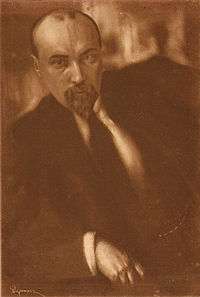
After the February Revolution of 1917 and the end of the czarist regime, Roerich, a political moderate who valued Russia's cultural heritage more than ideology and party politics, had an active part in artistic politics. With Maxim Gorky and Aleksandr Benois, he participated with the so-called "Gorky Commission" and its successor organization, the Arts Union (SDI). Both attempted to gain the attention of the Provisional Government and Petrograd Soviet on the need to form a coherent cultural policy and, most urgently, protect art and architecture from destruction and vandalism. At the same time, however, illness forced Roerich to leave the capital and reside in Karelia, the district bordering Finland. He had already quit the presidency of the World of Art society, and he now quit the directorship of the School of the Imperial Society for the Encouragement of the Arts. After the October Revolution and the acquisition of power of Lenin's Bolshevik Party, Roerich became increasingly discouraged about Russia's political future. During early 1918, he, Helena, and their two sons George and Sviatoslav emigrated to Finland.
Two unresolved historical debates are associated with Roerich's departure. First, it is often claimed that Roerich was a major candidate to direct a people's commissariat of culture (the Soviet equivalent of a ministry of culture) which the Bolsheviks considered establishing during 1917–1918, but that he refused to accept the job. In fact, Benois was the most likely choice to direct any such commissariat. It seems that Roerich was a preferred choice to manage its department of artistic education; the topic is rendered moot by the fact that the Soviets elected not to establish such a commissariat. Second, when he wished to reconcile with the USSR, Roerich maintained later that he had not left Soviet Russia deliberately, but that he and his family, living in Karelia (there he painted a series of pictures under the name "Karelian Suite"), had been isolated from their homeland when civil war began in Finland. However, Roerich's extreme hostility to the Bolshevik regime – prompted not so much by a dislike of communism as by his revulsion at Lenin's ruthlessness and his fear that Bolshevism would result in the destruction of Russia's artistic and architectural heritage – was amply documented. He illustrated Leonid Andreyev's anti-communist polemic "S.O.S." and had a widely published pamphlet, "Violators of Art" (1918–1919). Roerich believed that "the triumph of Russian culture would come about through a new appreciation of ancient myth and legend".[8]
After some months in Finland and Scandinavia, the Roerichs relocated to London, arriving during mid-1919. Engrossed with Theosophical mysticism, the Roerichs now had millenarian expectations that a new age was imminent, and they wished to travel to India as soon as possible. They joined the English-Welsh chapter of the Theosophical Society. It was in London, during March 1920, that the Roerichs initiated their own school of occultism, Agni Yoga, which they referred to also as "the system of living ethics." To earn passage to India, Roerich worked as a stage designer for Thomas Beecham's Covent Garden Theatre, but the enterprise ended unsuccessfully during 1920, and the artist never received full payment for his work. Among the notable people Roerich befriended while in England were the famed British Buddhist Christmas Humphreys, philosopher-author H. G. Wells, and the poet and Nobel laureate Rabindranath Tagore (whose grand-niece Devika Rani would later marry Roerich's son Sviatoslav).
Later, a successful exhibition resulted in an invitation from a director at the Art Institute of Chicago, offering to arrange for Roerich's art to tour the United States. During the autumn of 1920, the Roerichs traveled to America by sea.
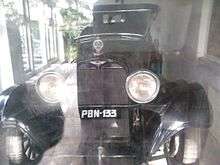
The Roerichs remained in the United States from October 1920 until May 1923. A large exhibition of Roerich's art, organized partly by U.S. impresario Christian Brinton and partly by the Chicago Art Institute, began in New York during December 1920 and toured the country, to San Francisco and back, during 1921 and early 1922. Roerich befriended acclaimed soprano Mary Garden of the Chicago Opera and received a commission to design a 1922 production of Rimsky-Korsakov's The Snow Maiden for her. During the exhibition, the Roerichs spent significant amounts of time in Chicago, New Mexico, and California.
They settled in New York City, which became the base of their many American operations. The Roerichs initiated several institutions during these years: Cor Ardens and Corona Mundi, both of which were meant to unite artists around the globe in the cause of civic activism; the Master Institute of United Arts, an art school with an exceptionally versatile curriculum, and the eventual home of the first Nicholas Roerich Museum; and an American Agni Yoga Society. They also joined various theosophical societies, and their activities with these groups dominated their lives.
Asian Expedition (1925–1929)
After leaving New York, the Roerichs – together with their son George and six friends – began the five-year-long 'Roerich Asian Expedition' that, in Roerich's own words: "started from Sikkim through Punjab, Kashmir, Ladakh, the Karakoram Mountains, Khotan, Kashgar, Qara Shar, Urumchi, Irtysh, the Altai Mountains, the Oyrot region of Mongolia, the Central Gobi, Kansu, Tsaidam, and Tibet" with a detour through Siberia to Moscow during 1926. Roerichs' Asian expedition attracted attention from the foreign services and intelligence agencies of the USSR, the United States, Great Britain, and Japan. In fact, prior to this expedition, Roerich himself solicited help of Soviet government and Bolshevik secret police to assist him in his expedition, promising in return to monitor British activities in the area, but received only a lukewarm response from Meer Trilisser, chief of the Soviet foreign intelligence at that time. On the one hand, the Bolsheviks assisted him with logistics when Roerich was traveling through Siberia and Mongolia. Yet, on the other hand, they refused to totally commit themselves to his reckless utopian project of the Sacred Union of the East – a spiritual utopia that boiled down to Roerich ambitious attempts to stir the Buddhist masses of inner Asia to create a highly spiritual cooperative commonwealth under the patronage of Bolshevik Russia. The official mission of this expedition, as Roerich put it, was to act as the embassy of Western Buddhism to Tibet. However, for Western media his expedition was presented as an artistic and scientific enterprise;[9] Between the summer of 1927 and June 1928 the expedition was thought to be lost, since communication with them ceased for a year. They had been attacked in Tibet and only the "superiority of our firearms prevented bloodshed... In spite of our having Tibet passports, the expedition was forcibly stopped by Tibetan authorities." The expedition was detained by the government for five months, and forced to live in tents in sub-zero conditions and to subsist on meagre rations. Five men of the expedition died during this time. During March 1928 they were allowed to leave Tibet, and trekked south to settle in India, where they initiated a research center, the Himalayan Research Institute.
During 1929 Nicholas Roerich was nominated for the Nobel Peace Prize by the University of Paris.[10] He received two more nominations during 1932 and 1935.[11] His concern for peace resulted in his creation of the Pax Cultura, the "Red Cross" of art and culture. His work for this cause also resulted in the United States and the twenty other nations of the Pan-American Union signing the Roerich Pact on April 15, 1935 at the White House. The Roerich Pact is an early international instrument protecting cultural property.
Manchurian expedition
During 1934–1935, the U.S. Department of Agriculture (then headed by Roerich admirer Henry A. Wallace) sponsored an expedition by Roerich and USDA scientists H. G. MacMillan and James F. Stephens to Inner Mongolia, Manchuria, and China. The expedition's purpose was to collect seeds of plants which prevent the destruction of benign layers of soil.
The expedition consisted of two parts. During 1934, they explored the Greater Khingan mountains and Bargan plateau in western Manchuria. During 1935, they explored parts of Inner Mongolia: the Gobi Desert, Ordos, and Helan Mountains. The expedition found almost 300 species of xerophytes, collected herbs, conducted archeological studies, and found antique manuscripts of great scientific importance.
Later life and World War II
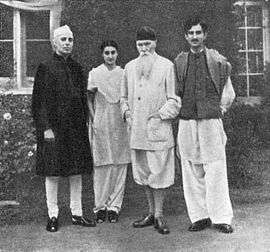
Roerich was in India during the Second World War, where he painted Russian epic heroic and saintly themes, including: Alexander Nevsky, The Fight of Mstislav and Rededia and Boris and Gleb.[12]
During 1942, Roerich received Jawaharlal Nehru at his house in Kullu and Nehru's daughter, Indira Gandhi. Together they discussed the fate of the new world: "We spoke about Indian-Russian cultural association, – Roerich wrote, – it is time to think about useful and creative cooperation ...”.[13]
Gandhi would later recall about several days spent together with Roerich's family: "That was a memorable visit to a surprising and gifted family where each member was a remarkable figure in himself, with a well-defined range of interests." ..."Roerich himself stays in my memory. He was a man with extensive knowledge and enormous experience, a man with a big heart, deeply influenced by all that he observed".
During the visit, "ideas and thoughts about closer cooperation between India and USSR were expressed. Now, after India wins independence, they have got its own real implementation. And as you know, there are friendly and mutually-understanding relationships today between both our countries".[14]
During 1942, the American-Russian cultural Association (ARCA) was created in New York. Its active participants were Ernest Hemingway, Rockwell Kent, Charlie Chaplin, Emil Cooper, Serge Koussevitzky, and Valeriy Ivanovich Tereshchenko. The Association's activity was welcomed by scientists like Robert Millikan and Arthur Compton.[15]
Roerich died on December 13, 1947.
Cultural legacy

Vice President of the United States Henry A. Wallace was a frequent correspondent and sometime advocate of Nicholas Roerich's teachings. Wallace became attracted to the idea of Sacred Union of the East, a spiritual and geopolitical utopia Nicholas and Helena Roerich contemplated to establish in the heart of Asia. Based on spiritual ideas, which the Roerichs claimed they received from otherworld masters, this utopia was to show the humankind a blueprint of ideal society. As the US Secretary of Agriculture, Wallace became so much interested in the whole project that he decided to sponsor the second Roerich expedition to Asia in 1933–1934. In the meantime, Helena Roerich was corresponding with US President Franklin D. Roosevelt, who was intrigued by her "fiery letters." The whole project ended in a disaster and resulted in energetic efforts by Wallace and FDR to cut their ties with the Roerichs. The whole incident later partially resurfaced and became controversial when Wallace campaigned for President during 1948 and portions of the correspondence were printed by columnist Westbrook Pegler, becoming known as the Guru Letters,[16]
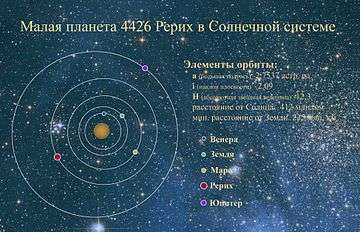
Presently, the Nicholas Roerich Museum in New York City is a major institution for Roerich's artistic work. Numerous Roerich societies continue to promote his theosophical teachings worldwide. His paintings can be seen in several museums including the Roerich Department of the State Museum of Oriental Arts in Moscow; the Roerich Museum at the International Centre of the Roerichs in Moscow; the Russian State Museum in Saint Petersburg, Russia; a collection in the Tretyakov Gallery in Moscow; a collection in the Art Museum in Novosibirsk, Russia; an important collection in the National Gallery for Foreign Art in Sofia, Bulgaria; a collection in the Art Museum in Nizhny Novgorod Russia; National Museum of Serbia ; the Roerich Hall Estate in Nagar village in Kullu Valley, India; the Sree Chitra Art Gallery, Thiruvananthapuram, India;[17] in various art museums in India; and a selection featuring several of his larger works in The Latvian National Museum of Art.
Roerich's biography and his controversial expeditions to Tibet and Manchuria have been examined recently by a number of authors, including two Russians, Vladimir Rosov and Alexandre Andreyev, American (Andrei Znamenski), and the German Ernst von Waldenfels.[18]
H.P. Lovecraft referred to the "strange and disturbing paintings of Nicholas Roerich" in his Antarctic horror story At the Mountains of Madness.
The minor planet 4426 Roerich in the Solar System was named in honor of Roerich.
During June 2013 during Russian Art Week in London, Roerich's Madonna Laboris sold at auction at Bonhams shop for £7,881,250 inc. buyer's premium, making it the most valuable painting ever sold at a Russian art auction.[19]
Gallery
-

And We are Opening the Gates, from the "Sancta" Series.
-

And We are Trying, from the "Sancta" Series.
-
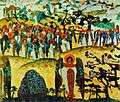
Treasure of angels
-

And We See, from the "Sancta" Series.
-

Monhegan, Maine.
-

The Messenger.
-
Nicolas Roerich. India, Kullu, 1947
 |
N. K. Roerich. About Shambala
Phonogram of 1929. |
| Problems playing this file? See media help. | |
See also
- Agni Yoga
- Banner of Peace
- Helena Roerich
- George de Roerich
- Morya (Theosophy)
- Roerich Pact
- Russian cosmism
- Svetoslav Roerich
- 4426 Roerich — minor planet
- Rerikhism
References
- ↑ Электронная библиотека Международного Центра Рерихов, ПЛАНЕТА «РЕРИХ»
- ↑ Nicholas Roerich: In Search of Shambala by Victoria Klimentieva, стр. 31
- ↑ Nicholas Roerich Museum
- ↑ Andrei Znamenski, Red Shambhala: Magic, Prophecy, and Geopolitics in the Heart of Asia, Quest Books (2011), p. 157
- ↑ Nicholas Roerich
- ↑ Nobel Prize Nomination Database
- ↑ Julie Besonen, "Visions of a Forgotten Utopian", New York Times, April 6, 2014.
- ↑ Bowlt, John E. (2008). Moscow and St. Petersburg 1900–1920: Art, Life and Culture. New York: The Vendome Press. p. 69. ISBN 978-0-86565-191-3.
- ↑ "Andrei Znamenski, "Nicholas Roerich Shambhala Warrior""..
- ↑ "Roerich Nominated for Peace Award". New York Times. March 3, 1929. Retrieved 2009-02-03.
- ↑ Nomination database
- ↑ Peter Leek (2005). Russian Painting. Parkstone International. pp. 256–. ISBN 978-1-78042-975-5. Retrieved June 23, 2013.
- ↑ N. Roerich. Diary Leaves. V. 3. – Moscow, International Centre of the Roerichs. – 1996. – p.39. ISBN 5-86988-056-4
- ↑ Interview with Indira Gandhi / Roerich's Empire. (Derzhava Rerikhov) (in Russian). / Collected Articles. – Moscow, International Centre of the Roerichs, Master-Bank. – 2004. – p.65. ISBN 5-86988-148-X
- ↑ Ruth Abrams Drayer (2005). Nicholas And Helena Roerich: The Spiritual Journey of Two Great Artists And Peacemakers. Quest Books. pp. 330–. ISBN 978-0-8356-0843-5. Retrieved June 23, 2013.
- ↑ "Andrei Znamenski, "Utopian in Power: Henry Wallace, Roerich, and the Sacred Union of the East"..
- ↑ "Dust throws a blanket over prized paintings"..
- ↑ Nicholas Roerich: the Messenger of Zvenigorod (vol. 1: The Great Plan, vol. 2: The New Country) (2002–2004) [summary of the books in English at http://lebendige-ethik.net/engl/4-Rosovs_books.html]; Alexandre Andreyev, Gimalaiski mif i ego tvotry [Himalayan Myth and its Makers] (St. Petersburg: St. Petersburg University Press, 2004) [in Russian]; Andrei Znamenski, Red Shambhala: Magic, Prophesy, and Geopolitics in the Heart of Asia (Quest Books, 2011) [see an excerpt from the book at http://www.trimondi.de/EN/Red_Shambhala.htm]; Ernst von Waldenfels, Nicholas Roerich: Kunst, Macht und Okkultismus (Osburg, 2011)
- ↑ http://www.bonhams.com/auctions/20841/lot/63/
External links
| Wikiquote has quotations related to: Nicholas Roerich |
| Wikimedia Commons has media related to Nicholas Roerich. |
- International Centre of the Roerichs
- Nicholas Roerich Museum (New York)
- International Roerich Memorial Trust (India)
- Estonian Roerich Society
- Roerich-movement on the Internet (in Russian)
- Paintings Gallery
- Nicholas Roerich Estate Museum in Izvara
- Roerich Family
- Find A Grave
- Catalogue of Nicholas Roerich`s works from the collection of Gorlovka Art Museum
|
